
A | B | C | D | E | F | G | H | CH | I | J | K | L | M | N | O | P | Q | R | S | T | U | V | W | X | Y | Z | 0 | 1 | 2 | 3 | 4 | 5 | 6 | 7 | 8 | 9
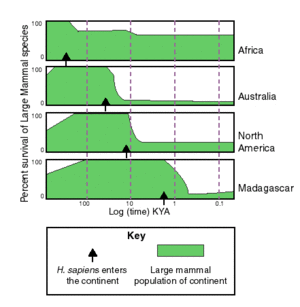
| Mammals by population |
|---|
 |
- Extinct in the wild (EW): 2 species
- Critically endangered (CR): 203 species
- Endangered (EN): 505 species
- Vulnerable (VU): 536 species
- Near threatened (NT): 345 species
- Least concern (LC): 3,306 species
- Data deficient (DD): 872 species
- 5850 extant species have been evaluated
- 4978 of those are fully assessed[a]
- 3651 are not threatened at present[b]
- 1244 to 2116 are threatened[c]
- 81 to 83 are extinct or extinct in the wild:
- 81 extinct (EX) species[d]
- 2 extinct in the wild (EW)
- 0 possibly extinct
- 0 possibly extinct in the wild
- ^ excludes data deficient evaluations.
- ^ NT and LC.
- ^ Threatened comprises CR, EN and VU. Upper estimate additionally includes DD.
- ^ Chart omits extinct (EX) species
Recently extinct mammals are defined by the International Union for Conservation of Nature (IUCN) as any mammals that have become extinct since the year 1500 CE.[1] Since then, roughly 80 mammal species have become extinct.[2]
Extinction of taxa is difficult to confirm, as a long gap without a sighting is not definitive, but before 1995 a threshold of 50 years without a sighting was used to declare extinction.[1]
One study found that extinction from habitat loss is the hardest to detect, as this might only fragment populations to the point of concealment from humans. Some mammals declared as extinct may very well reappear.[1] For example, a study found that 36% of purported mammalian extinction had been resolved, while the rest either had validity issues (insufficient evidence) or had been rediscovered.[3]
As of June 2023, the IUCN listed 233 mammalian species as "critically endangered", while 27% of all mammalian species were threatened with extinction.[4]
Conventions
All species listed as "Extinct" are classified as being extinct (no known remaining individuals left) by the International Union for Conservation of Nature (IUCN). All species listed as Extinct in the wild are classified as being extinct in the wild, meaning that all remaining individuals of the species reside in captivity. All species listed as "Possibly extinct" are classified as being critically endangered, as it is unknown whether or not these species are extinct.[5] Extinct subspecies such as the Javan tiger (Panthera tigris sondaica)[6] are not listed here as the species, in this case Panthera tigris, is still extant. The IUCN Redlist classification for each species serves as a citation, and the superscripted "IUCN" by the date is a link to that species' page. A range map is provided wherever available, and a description of their former or current range is given if a range map is not available.
Causes of extinction
Habitat degradation is currently the main anthropogenic cause of species extinctions. The main cause of habitat degradation worldwide is agriculture, with urban sprawl, logging, mining and some fishing practices close behind. The physical destruction of a habitat, both directly (deforestation for land development or lumber) and indirectly (burning fossil fuels), is an example of this.[7][8]
Also, increasing toxicity, through media such as pesticides, can kill off a species very rapidly, by killing all living members through contamination or sterilizing them. Persistent organic pollutants (POPs), for example, can bioaccumulate to hazardous levels, getting increasingly more dangerous further up the food chain.[9]
Disease can also be a factor: white nose syndrome in bats, for example, is causing a substantial decline in their populations and may even lead to the extinction of a species.[10]
Overhunting also has an impact. Terrestrial mammals, such as the tiger and deer, are mainly hunted for their pelts and in some cases meat, and marine mammals can be hunted for their oil and leather. Specific targeting of one species can be problematic to the ecosystem because the sudden demise of one species can inadvertently lead to the demise of another (coextinction) especially if the targeted species is a keystone species. Sea otters, for example, were hunted in the maritime fur trade, and their drop in population led to the rise in sea urchins—their main food source—which decreased the population of kelp—the sea urchin's and Steller's sea cow's main food source—leading to the extinction of the Steller's sea cow.[11] The hunting of an already limited species can easily lead to its extinction, as with the bluebuck whose range was confined to 1,700 square miles (4,400 km2) and which was hunted into extinction soon after discovery by European settlers.[12]
Australia
Island creatures are usually endemic to only that island, and that limited range and small population can leave them vulnerable to sudden changes.[13] While Australia is a continent and not an island, due to its geographical isolation, its unique fauna has suffered an extreme decline in mammal species, 10% of its 273 terrestrial mammals, since European settlement (a loss of one to two species per decade); in contrast, only one species in North America has become extinct since European settlement.[citation needed] Furthermore, 21% of Australia's mammals are threatened, and unlike in most other continents, the main cause is predation by feral species, such as cats.[14]
Extinct species
A species is declared extinct after exhaustive surveys of all potential habitats eliminate all reasonable doubt that the last individual of a species, whether in the wild or in captivity, has died.[15] Recently extinct species are defined by the IUCN as becoming extinct after 1500 CE.[1]
| Common name | Binomial name | Order | Date of extinction | Former range | Picture |
|---|---|---|---|---|---|
| Broad-faced potoroo | Potorous platyops Gould, 1844 |
Diprotodontia | 1875 1 | Australia | 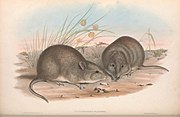
|
| Eastern hare wallaby | Lagorchestes leporides Gould, 1841 |
Diprotodontia | 1889 1 | 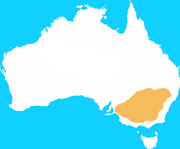 Australia |

|
| Lake Mackay hare-wallaby | Lagorchestes asomatus Finlayson, 1943 |
Diprotodontia | 1932 1 | Australia | |
| Desert rat-kangaroo | Caloprymnus campestris Gould, 1843 |
Diprotodontia | 1935 1 |  Australia |
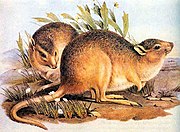
|
| Thylacine, or Tasmanian wolf/tiger |
Thylacinus cynocephalus Harris, 1808 |
Dasyuromorphia | 1936 1 |  Australia, Tasmania |

|
| Toolache wallaby | Macropus greyi Waterhouse, 1846 |
Diprotodontia | 1939 1 | Australia | 
|
| Desert bandicoot | Perameles eremiana Spencer, 1837 |
Peramelemorphia | 1943 1 | Australia | 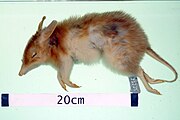
|
| New South Wales barred bandicoot[16] | Perameles fasciata Gray, 1841 |
Peramelemorphia | mid-19th century | Australia | 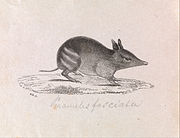
|
| Southwestern barred bandicoot[16] | Perameles myosuros Wagner, 1841 |
Peramelemorphia | mid-19th century | Australia | 
|
| Southern barred bandicoot[16] | Perameles notina Thomas, 1922 |
Peramelemorphia | mid-19th century | Australia | |
| Nullarbor barred bandicoot[16] | Perameles papillon Travouillon & Phillips, 2018 |
Peramelemorphia | early 20th century | Australia | |
| Lesser bilby, or Yallara |
Macrotis leucura Thomas, 1887 |
Peramelemorphia | 1960s 1 | 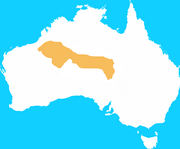 Australia |
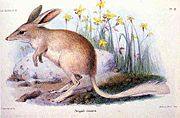
|
| Southern pig-footed bandicoot | Chaeropus ecaudatus Ogilby, 1838 |
Peramelemorphia | 1950s 1 | 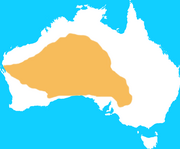 Australia |
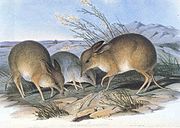
|
| Northern pig-footed bandicoot | Chaeropus yirratji Travouillon et al., 2019 |
Peramelemorphia | 1950s | 
|
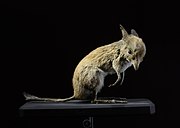
|
| Crescent nail-tail wallaby | Onychogalea lunata Gould, 1841 |
Diprotodontia | 1956 1 | Australia (western and central) | 
|
| Red-bellied gracile opossum, or red-bellied gracile mouse opossum |
Cryptonanus ignitus Díaz, Flores and Barquez, 2002 |
Didelphimorphia | 1962 1 | Argentina | |
| Nullarbor dwarf bettong | Bettongia pusilla McNamara, 1997 |
Diprotodontia | early 1500s 1 | Australia (Nullarbor Plain) | |
| Steller's sea cow | Hydrodamalis gigas von Zimmermann, 1780 |
Sirenia | 1768 1 | Commander Islands (Russia, United States) | 
|
| Bramble Cay melomys | Melomys rubicola Thomas, 1924 |
Rodentia | 2016 1 | Australia (Bramble Cay) | 
|
| Oriente cave rat | Boromys offella Miller, 1916 |
Rodentia | early 1500s 1 | Cuba | 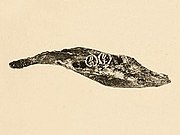
|
| Torre's cave rat | Boromys torrei Allen, 1917 |
Rodentia | early 1500s 1 | Cuba | 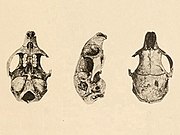
|
| Imposter hutia | Hexolobodon phenax Miller, 1929 |
Rodentia | early 1500s 1 | Hispaniola (currently Haiti and the Dominican Republic) | |
| Montane hutia | Isolobodon montanus Miller, 1922 |
Rodentia | early 1500s 1 | Hispaniola | |
| Dwarf viscacha | Lagostomus crassus Thomas, 1910 |
Rodentia | early 1900s 1 | Peru | |
| Galápagos giant rat | Megaoryzomys curioi Niethammer, 1964 |
Rodentia | 1500s 1 | Santa Cruz Island (Galápagos) | 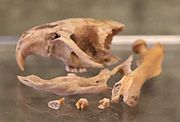
|
| Cuban coney | Geocapromys columbianus Chapman, 1892 |
Rodentia | early 1500s 1 | Cuba | |
| Hispaniolan edible rat | Brotomys voratus Miller, 1916 |
Rodentia | 1536–1546 1 | Hispaniola | |
| Puerto Rican hutia | Isolobodon portoricensis Allen, 1916 |
Rodentia | early 1900s 1 | Hispaniola; introduced to Puerto Rico, Saint Thomas Island, Saint Croix, U.S. Virgin Islands and Mona Island | |
| Big-eared hopping mouse | Notomys macrotis Thomas, 1921 |
Rodentia | 1843 1 | Australia (central Western Australia) | |
| Darling Downs hopping mouse | Notomys mordax Thomas, 1921 |
Rodentia | 1846 1 | Australia (Darling Downs, Queensland) | |
| White-footed rabbit-rat | Conilurus albipes Lichtenstein, 1829 |
Rodentia | early 1860s 1 | Australia (eastern coast) | 
|
| Capricorn rabbit rat | Conilurus capricornensis Cramb and Hocknull, 2010 |
Rodentia | early 1500s 1 | Australia (Queensland) | |
| Short-tailed hopping mouse | Notomys amplus Brazenor, 1936 |
Rodentia | 1896 1 | Australia (Great Sandy Desert) | |
| Long-tailed hopping mouse | Notomys longicaudatus Gould, 1844 |
Rodentia | 1901 1 | Australia | 
|
| Great hopping mouse | Notomys robustus Mahoney, Smith and Medlin, 2008 |
Rodentia | mid-1800s 1 | Australia (Flinders Ranges and Davenport Ranges) | |
| Desmarest's pilorie, or Martinique giant rice rat |
Megalomys desmarestii Fischer, 1829 |
Rodentia | 1902 1 | Martinique | 
|
| Saint Lucia pilorie, or Saint Lucia giant rice rat |
Megalomys luciae Major, 1901 |
Rodentia | 1881 1 | Saint Lucia | 
|
| Bulldog rat | Rattus nativitatis Thomas, 1888 |
Rodentia | 1903 1 | Christmas Island | 
|
| Maclear's rat | Rattus macleari Thomas, 1887 |
Rodentia | 1903 1 | Christmas Island | 
|
| Darwin's Galápagos mouse | Nesoryzomys darwini Osgood, 1929 |
Rodentia | 1930 1 | Galápagos Islands | |
| Gould's mouse | Pseudomys gouldii Waterhouse, 1839 |
Rodentia | 1930 1 | Australia (southern half) | 
|
| Plains rat, or Palyoora |
Pseudomys auritus Thomas, 1910 |
Rodentia | early 1800s 1 | Australia (Kangaroo Island and the Younghusband Peninsula) | |
| Pemberton's deer mouse | Peromyscus pembertoni Burt, 1932 |
Rodentia | 1931 1 | San Pedro Nolasco Island, Mexico | 
|
| Samaná hutia | Plagiodontia ipnaeum Johnson, 1948 |
Rodentia | early 1500s [a] 1 | Hispaniola | |
| Hispaniola monkey | Antillothrix bernensis MacPhee, Horovitz, Arredondo, & Jimenez Vasquez, 1995 |
Primates | early 16th century | Hispaniola (currently Dominican Republic) | |
| Lesser stick-nest rat, or white-tipped stick-nest rat |
Leporillus apicalis John Gould, 1854 |
Rodentia | 1933 1 | Australia (west-central) | 
|
| Indefatigable Galápagos mouse | Nesoryzomys indefessus Thomas, 1899 |
Rodentia | 1934 1 | Galápagos Islands | |
| Little Swan Island hutia | Geocapromys thoracatus True, 1888 |
Rodentia | 1955 1 | Swan Islands, Honduras | 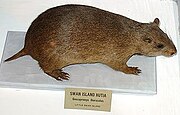
|
| Blue-gray mouse | Pseudomys glaucus Thomas, 1910 |
Rodentia | 1956 1 | Australia (Queensland, New South Wales)
Zdroj:https://en.wikipedia.org?pojem=List_of_extinct_mammals Text je dostupný za podmienok Creative Commons Attribution/Share-Alike License 3.0 Unported; prípadne za ďalších podmienok. Podrobnejšie informácie nájdete na stránke Podmienky použitia.
Analytika
Antropológia Aplikované vedy Bibliometria Dejiny vedy Encyklopédie Filozofia vedy Forenzné vedy Humanitné vedy Knižničná veda Kryogenika Kryptológia Kulturológia Literárna veda Medzidisciplinárne oblasti Metódy kvantitatívnej analýzy Metavedy Metodika Text je dostupný za podmienok Creative
Commons Attribution/Share-Alike License 3.0 Unported; prípadne za ďalších
podmienok. www.astronomia.sk | www.biologia.sk | www.botanika.sk | www.dejiny.sk | www.economy.sk | www.elektrotechnika.sk | www.estetika.sk | www.farmakologia.sk | www.filozofia.sk | Fyzika | www.futurologia.sk | www.genetika.sk | www.chemia.sk | www.lingvistika.sk | www.politologia.sk | www.psychologia.sk | www.sexuologia.sk | www.sociologia.sk | www.veda.sk I www.zoologia.sk |


